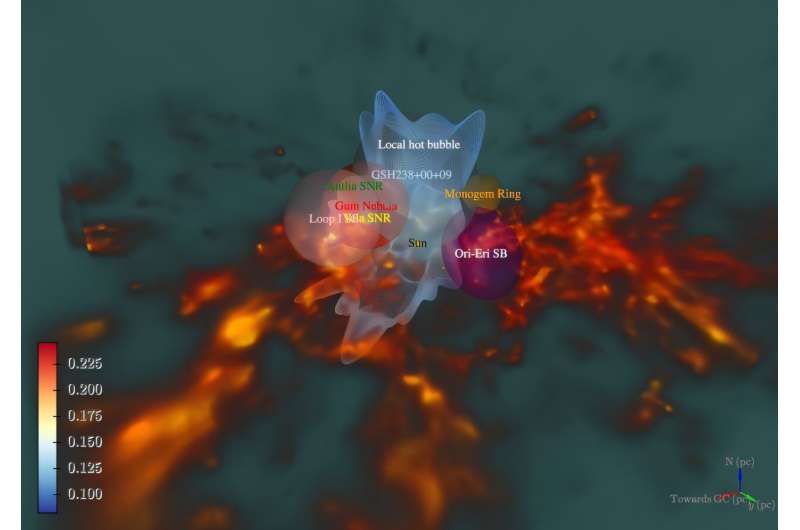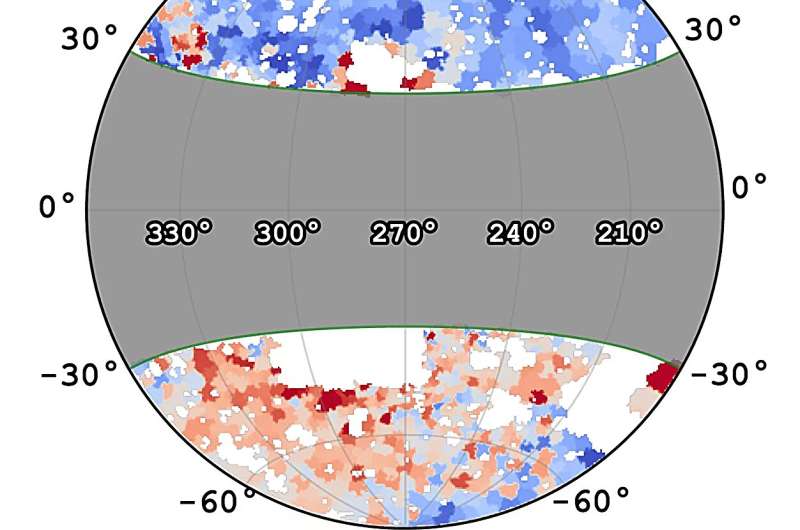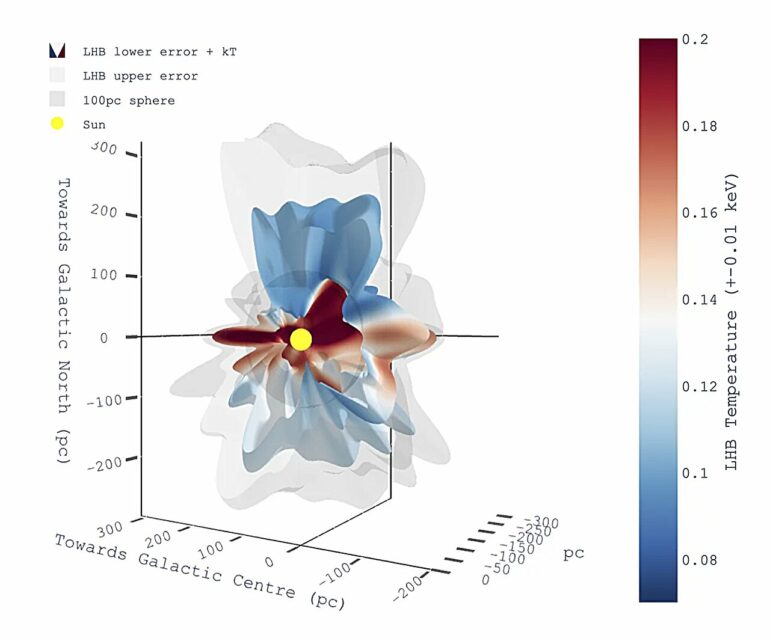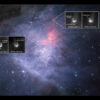Our solar system dwells in a low-density environment called the Local Hot Bubble (LHB), filled by a tenuous, million-degree hot gas emitting dominantly in soft X-rays. A team led by scientists at the Max Planck Institute for Extraterrestrial Physics (MPE) used the eROSITA All-Sky Survey data and found a large-scale temperature gradient in this bubble, possibly linked with past supernova explosions that expanded and reheated the bubble.
The wealth of the eROSITA data also allowed the team to create a new 3D model of the hot gas in the solar neighborhood. The highlight of this work features the discovery of a new interstellar tunnel towards the constellation Centaurus, potentially joining our LHB with a neighboring superbubble. The research is published in the journal Astronomy & Astrophysics.
The idea of the LHB has been around for about half a century, first developed to explain the ubiquitous X-ray background below 0.2 keV. Photons of such energies cannot travel very far in the interstellar medium before they are absorbed. In conjunction with the observation that there is almost no interstellar dust in our immediate environment, the scenario where a soft X-ray emitting plasma displaces the neutral materials in the solar neighborhood, forming the “Local Hot Bubble,” was put forth.
This understanding of our immediate environment was not without its challenges, especially after the discovery of the solar wind charge exchange process in 1996—an interaction between the solar wind ions and neutral atoms within the Earth’s geocorona and the heliosphere that emits X-rays at similar energies as the LHB. After years of analysis, the consensus now is that both contribute to the soft X-ray background, and the LHB must exist to explain the observations.
The eROSITA telescope is the first X-ray observatory to observe the sky from an orbit completely external to the Earth’s geocorona, avoiding the latter’s contamination. Also, the timing of the first eROSITA All-Sky Survey (eRASS1) coincided with the solar minimum, significantly reducing the heliospheric solar wind charge exchange contamination.
“In other words, the eRASS1 data released to the public this year provides the cleanest view of the X-ray sky to date, making it the perfect instrument for studying the LHB,” says Michael Yeung from MPE, the lead author of this work.

3D model of the solar neighborhood. The color bar represents the temperature of the LHB as colored on the LHB surface. The direction of the Galactic Center (GC) and Galactic North (N) is shown in the bottom right. © Michael Yeung / MPE
eROSITA’s unparalleled X-ray observations
The team divided the western Galactic hemisphere into about 2,000 regions and extracted and analyzed the spectra from each one. They also leveraged data from ROSAT, the predecessor of eROSITA built also by MPE, which complements the eROSITA spectra at energies lower than 0.2 keV.
They found a clear temperature dichotomy in the LHB, with the Galactic South (0.12 keV; 1.4 MK) slightly hotter than the Galactic North (0.10 keV; 1.2 MK). This feature could be explained by the latest numerical simulations of the LHB caused by supernova explosions in the last few million years.
Diffuse X-ray background spectra inform scientists not just of the temperature but also of the 3D structure of the hot gas. Previous work by the same team has established that the density of the LHB is relatively uniform, calibrating the density of the hot gas with sight lines to giant molecular clouds located on the surface of the LHB.
Relying on this assumption, they generated a new 3D model of the LHB from the measured intensity of the LHB emission in each sight line. They found the LHB has a larger extent towards the Galactic poles as expected, as the hot gas prefers to expand towards directions of the least resistance, away from the Galactic disk.
“This is not surprising, as was already found by the ROSAT survey,” pointed out by Michael Freyberg, a core author of this work who was also a part of the pioneering work in the ROSAT era three decades ago.
“What we didn’t know was the existence of an interstellar tunnel towards Centaurus, which carves a gap in the cooler interstellar medium (ISM). This region stands out in stark relief thanks to the much-improved sensitivity of eROSITA and a vastly different surveying strategy compared to ROSAT,” added Freyberg.
The authors of this work suggest the Centaurus tunnel may just be a local example of a wider hot ISM network sustained by stellar feedback across the galaxy—a popular idea proposed in the 70s that remains difficult to prove.

Temperature map of the LHB in the western Galactic hemisphere in zenithal equal-area projection. The high-latitude region in the northern and southern hemispheres exhibits a clear temperature dichotomy. © Michael Yeung / MPE
A 3D model of the solar neighborhood
In addition to the 3D LHB model, the team compiled a list of known supernova remnants, superbubbles, and 3D dust information from the literature and created an interactive 3D model of the solar neighborhood.
Some features of the LHB could be easily appreciated from such a representation, for instance, the well-known Canis Majoris tunnel on the Galactic disk, possibly connecting the LHB to the Gum nebula or another superbubble (called GSH238+00+09), as well as dense molecular clouds (in orange) lying close to the surface of the LHB in the direction of the Galactic Center (GC).
Recent works found that these clouds possess velocities in the radial direction (away from us). The location and the velocity of the clouds could be explained if they were formed from the condensation of swept-up materials during the early stage of the LHB formation.
“Another interesting fact is that the sun must have entered the LHB a few million years ago, a short time compared to the age of the sun, remarked Gabriele Ponti, a co-author of this work. “It is purely coincidental that the sun seems to occupy a relatively central position in the LHB as we continuously move through the Milky Way.”
More information:
Michael C. H. Yeung et al, The SRG/eROSITA diffuse soft X-ray background, Astronomy & Astrophysics (2024). DOI: 10.1051/0004-6361/202451045
Provided by
Max Planck Society
Citation:
eROSITA survey unveils asymmetries in temperature and shape of our Local Hot Bubble (2024, October 29)



